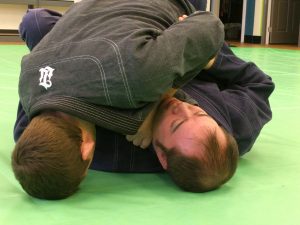By Revolution BJJ black belt Daniel Frank
In my jiu jitsu career, from white belt up to black belt, there has been one attack that I know I can rely on to win matches with: the cross collar choke. The cross collar choke, despite being one of the first chokes that a jiu jitsu player is taught, is very hard to master. Once mastery of the choke is attained, opponents beware — it can come from almost any position.

I was taught and have practiced the cross collar choke almost every single day since white belt. There are a few points that are essential in the jiu jitsu player’s attempt to master this choke.
- Initial Grip
Probably the most important movement in the cross collar choke is establishing the initial grip. Without a proper, and strong, initial grip the whole attack will fall apart. For the initial grip both hands are necessary to sink the choking grip. Use your bottom hand to open your opponent’s jacket enough so you can slide your choking hand (palm up) deep into the opponent’s collar. The target is the washing tag at the back of your opponent’s jacket. Once you can feel the tag with the tips of your fingers turn your thumb inwards so that it points at your opponent’s head. This will place the radius bone in your forearm flush against your opponent’s neck, pinching closed the carotid artery on one side of the neck. This maneuver will also lower your elbow into your opponent’s chest, making it harder for the opponent to defend the choke.

- Position
Once the initial grip is sunk you need to maneuver your body into the correct position in order to sink an effective second grip. Let your legs do the work for you. Your legs are a lot stronger than your arms, so they are ideal for a task such as this. You will have to open your guard (the scary part) and place your feet on the floor on either side of your opponent. Using the leg on the opposite side of your initial grip, push your opponent’s body sideways so you have a unobstructed pathway to make your second grip.

- The Second Grip
There are three different hand positions that I have found are effective in securing the second grip of the choke. It is important to not force any of the hand positions, but rather, choose one position according to circumstance. If the opponent’s collar is open enough to place your thumb inside (with your palm down) do so; this is the strongest grip that you can make. Perhaps your opponent has just tied his belt and securely closed his jacket. There might not be enough room to place your thumb into your opponent’s collar. Instead, use your hand (palm down) to grab the extra cloth that bunches up above the opponent’s shoulder. A third hand position is possible when the jacket is closed tightly and there is no bunched up material available to grab above the shoulder. By simulating a karate chop against your opponent’s neck and curling your fingers over their shoulder you can secure a tight hand position. Once one of these hand positions is secured it is important that your forearm is flush up against the opponent’s neck and also below the opponent’s jawline. The second artery is almost pinched off.

- Finish
In order to pinch off the second artery and finish the choke it is important that you pull your arms and legs in correctly to finish the submission and not defeat your own efforts by pulling in the wrong direction. Your whole body is trying to finish the choke, so use your legs to pull the opponent’s body into yours. Imagine you are doing a reverse crunch and bringing your knees back to your chest. While engaging your legs pull your elbows down past your ribs. This will tighten the vise of the choke and force your opponent to give up. Do not pull your elbows laterally as that will relieve the pressure on the carotid arteries and eliminate the submission.
- Patience
The best thing about the cross collar choke is that you are applying it from a strong position, or a position in which you feel comfortable. Be patient. If you are attempting the choke and your opponent does not tap after a few seconds, reassess the steps of the choke to locate the problem. Fix that problem and attempt the choke again.
By studying the mechanics of a strong technique like the cross collar choke, and practicing the steps of the submission, the technique will become more natural. Before you realize it, the choke will be one of the most deadly submissions in your arsenal and keep you on the pathway to victory.